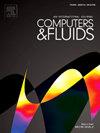A critical comparison of the implementation of granular pressure gradient term in Euler–Euler simulation of gas–solid flows
IF 2.5
3区 工程技术
Q3 COMPUTER SCIENCE, INTERDISCIPLINARY APPLICATIONS
引用次数: 0
Abstract
Numerical solution of Euler–Euler model using different in-house, open source and commercial software can generate significantly different results, even when the governing equations and the initial and boundary conditions are exactly same. Unfortunately, the underlying reasons have not been identified yet. In this article, three methods for calculating the granular pressure gradient term are presented for two-fluid model of gas–solid flows and implemented implicitly or explicitly into the solver in OpenFOAM®: Method assumes that the granular pressure gradient is equal to the elastic modulus plus the solid concentration gradient; Method directly calculates the gradient using a difference scheme; Method , which is proposed in this work, calculates the gradient as the sum of two partial derivatives: one related to the solid volume fraction and the other related to the granular energy. Obviously, only Methods and are consistent with kinetic theory of granular flow. It was found that the difference between all methods is small for bubbling fluidization. While for circulating fluidization, both Methods and are capable of capturing non-uniform structures and producing superior results over Method . The contradictory conclusions made from the simulation of different fluidization regimes is due to the different contribution of the term related to the granular energy gradient. Present study concludes that the implementation method of granular pressure gradient may have a significant impact on the hydrodynamics of gas–solid flows and is probably a key factor contributing to the observed differences between different simulation software.
欧拉-欧拉气固流动模拟中颗粒压力梯度项实现的关键比较
在控制方程、初始条件和边界条件完全相同的情况下,使用不同的内部软件、开源软件和商业软件对Euler-Euler模型进行数值求解,会产生明显不同的结果。不幸的是,根本原因尚未查明。本文提出了三种计算气固两流体模型颗粒压力梯度项的方法,并将其隐式或显式地实现到OpenFOAM®的求解器中:方法一假设颗粒压力梯度等于弹性模量加上固体浓度梯度;方法二采用差分格式直接计算梯度;本文提出的方法III将梯度计算为两个偏导数的和:一个与固体体积分数有关,另一个与颗粒能量有关。显然,只有方法II和方法III符合颗粒流动的动力学理论。结果表明,对于鼓泡流化,各种方法之间的差异很小。而对于循环流化,方法II和方法III都能够捕获非均匀结构并产生优于方法i的结果。从不同流化制度的模拟中得出的矛盾结论是由于与颗粒能量梯度相关的项的不同贡献。本研究认为,颗粒压力梯度的实现方法可能会对气固流动的流体动力学产生重大影响,并且可能是导致不同模拟软件之间观察到差异的关键因素。
本文章由计算机程序翻译,如有差异,请以英文原文为准。
求助全文
约1分钟内获得全文
求助全文
来源期刊

Computers & Fluids
物理-计算机:跨学科应用
CiteScore
5.30
自引率
7.10%
发文量
242
审稿时长
10.8 months
期刊介绍:
Computers & Fluids is multidisciplinary. The term ''fluid'' is interpreted in the broadest sense. Hydro- and aerodynamics, high-speed and physical gas dynamics, turbulence and flow stability, multiphase flow, rheology, tribology and fluid-structure interaction are all of interest, provided that computer technique plays a significant role in the associated studies or design methodology.
 求助内容:
求助内容: 应助结果提醒方式:
应助结果提醒方式:


